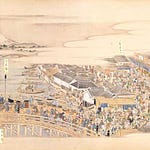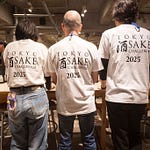Welcome to Issue #120 of SIN.
While the weather outside tells a different story, the calendar has decreed that we are stepping into autumn. Many things in Japan run like clockwork and the approach to the seasons is one of them. Despite the temperatures still hitting the mid-thirties Celsius (90-ish Fahrenheit) and levels of humidity which see our shirts soaked in sweat by 9am,everything else around us is telling us that fall is here.
The supermarkets and convenience stores have already removed summer seasonal products and begun replacing them with autumn inspired snacks and candies, adorned with obligatory images of orange falling leaves. No more t-shirts on sale at Uniqlo; it’s all cardigans and sweaters!
Weather be damned! If the calendar says it’s autumn, then it’s autumn!
And for sake drinkers, the onset of the autumn declaration means one thing: hiyaoroshi (and akiagari - so maybe two things).
The hiyaoroshi season inspires a number of events around the country such as a special tasting event recently held in Fukuoka which featured 24 local breweries offering their fall releases. Spring, summer or even new season shiboritate releases don’t quite garner the kind of attention that hiyaoroshi enjoys from sake consumers. And despite ongoing concerns and discussions regarding the effect of recent extreme temperatures on the maturation period for fall sake, that popularity and attention is showing few signs of wavering.
So, if you’re in Japan, get out and get your hands on some of that hiyaoroshi goodness. If you’re outside Japan, then you’ll just have to wait a little longer. But don’t worry, you’ll get yours soon enough.
And now for the news…
Long Hot Summer
Japan- The summer for 2024 has yet again been extremely hot and the effects will be felt in the sake industry.
In an interview with a local news outlet, Kenta Hara, kuramoto of Yoneda Shuzō in Shimane Prefecture, brewers of the brand Toyonoaki, commented that the excessive heat has meant the brewery may have to cease brewing its flagship sake, Junmai Ginjo Matsuezukushi after 30 years of production.
One of the local Matsue farmers who grows the Yamada Nishiki for use in the Yoneda Shuzō’s sake, Tomonori Kaku, reported that since 2022 the Yamada Nishiki plants have not bore sufficient grains due to the excessive heat.
In 2023, 99.9% of his Yamada Nishiki plantings did not pollinate. Despite planning to harvest 5 tons, only 60kg of rice was salvaged from the 100ha field. High temperatures stunt pollination, and when the plant doesn’t produce grains the ears grow straight up due to the lack of weight.
Adding to the woes, rice grown under extreme heat conditions tends to crack easily and is difficult to mill.

Yet another problem facing farmers is pests in the form of shield bugs (better known as stink bugs). The number of stink bugs has increased greatly over the past few years, forcing farmers to use pesticides they might not normally have needed to.
Hara lamented that while there is no way to combat nature, he hopes he can work something out with his farmers in order to overcome these challenges.
Source - Yahoo
JG: This is the kind of thing about which we very rarely hear. The fact that in 2023, 99.9% of the Yamada Nishiki plants did not pollinate is astounding. Sure, that was one grower in one region, but the fact that such a thing is possible is a cause for great concern. I hope things improve (i.e. cool down) soon.
米田酒造 (豊の秋)純米吟醸松江づくし
Hands Off Our Nihonshu!
Japan- On July 31, the Japan Sake Shochu Makers Association (JSS), issued a release to the press titled “The differences between seishu and sake designations”. The memorandum emphasizes that sake made from rice produced overseas or brewed overseas cannot be labeled as “nihonshu”.
The message comes at a time when the popularity of sake continues to rise overseas, and in tandem, the number of producers of sake in countries outside of Japan has also increased. JSS and its members recognize that it is in their best interests to protect their rights and the global brand of nihonshu.
Much of the confusion around terminology stems from the multiple terms that exist in the Japanese language used to describe “sake” and alcohol. In Japanese “sake” can refer to any alcoholic beverage, however depending on the context, it is often used when referring to “nihonshu” or the less often used legal term, “seishu”. Adding to the confusion is the polite form ”o-sake”, which again can be any form of alcohol, but in certain contexts may be used to describe nihonshu, which as surely everyone knows, translates directly as “Japanese sake”.
While using the terms “sake” and “nihonshu” interchangeably in Japan rarely causes serious confusion it becomes a more contentious issue when these terms are used to describe foreign-made sake. Similar issues exist in western liquors where the term Champagne was (and still often is) mistakenly used to describe any sparkling wine regardless of where it was produced. Or the term “Scotch” being used for any form of grain whisky.
The National Tax Agency essentially protected “nihonshu” when it was registered as a geographical indication (GI) in December 2015 for Japan produced sake using Japanese rice. GI is an intellectual property right established by the World Trade Organization (WTO), which allows the exclusive use of the name of the region of origin if the characteristics and quality unique to that region have been established. Only products produced in the production area and meeting certain production standards are allowed to use the GI recognized name.
Under the Japan-EU Economic Partnership Agreement, effective as of 2019, Nihonshu is protected and recognized in Europe. The US is also working toward similar protection with Japan, with procedures to protect sake in its trade agreements with Japan.
One could say that Japan is learning from past experiences in the way the term wagyu (which translates directly as “Japanese beef”) was adopted and popularized by farmers in Australia, USA and Europe to describe locally raised beef that contained a high marble ratio (high fat content). The protection of the wagyu brand was slow in coming and to date Australian farmers continues to profit more from wagyu sales than Japanese wagyu producers.
Source - Yomiuri
JG: Indeed, the sake industry was too slow in protecting these terms, and it is great to see them do what can be done to salvage something effective. Yes, it will take some time for consumers ‘round the world to learn that seishu is the legal term for sake, and defines sake as we know it by production methods and ingredients, clearly defining it within that vague term sake. While I do not think very many, if any, overseas producers would try to call their product “nihonshu,” the effort to ensure that does not happen is a strong affirmation.
Kochi Welcomes Number 19
Kochi- A new brewery in Kochi Prefecture is preparing to release its first sake to the public next month.
Listen to this episode with a 7-day free trial
Subscribe to Sake Industry News to listen to this post and get 7 days of free access to the full post archives.












